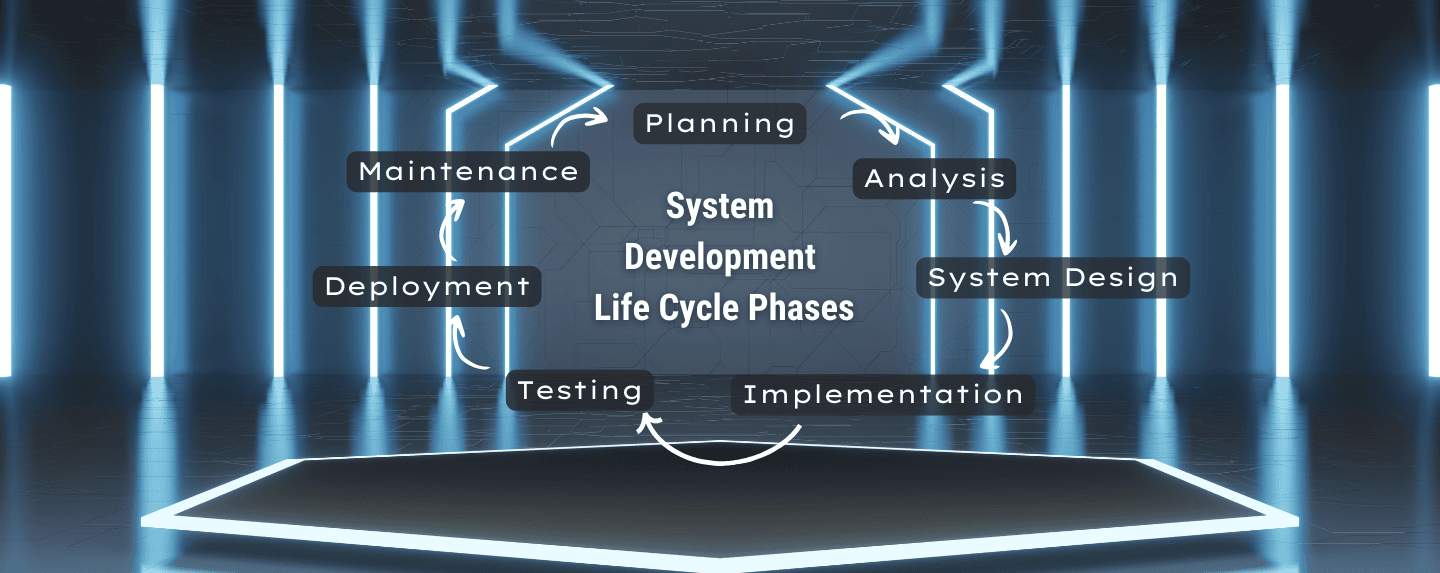The System Development Life Cycle (SDLC) is an essential framework for project managers overseeing the creation and implementation of custom software solutions. By adhering to its phases, businesses can ensure a structured and efficient process, ultimately delivering high-quality systems that meet user needs and business objectives.
Introduction to the System Development Life Cycle
The System Development Life Cycle (SDLC) is a methodical process used for planning, creating, testing, and deploying information systems. It serves as a blueprint, guiding the development team through a planning phase and testing phase, ensuring that each aspect of the system is considered and addressed. From initial concept to deployment and maintenance, the SDLC provides a structured approach that minimizes risks, manages resources effectively, and delivers a high-quality product.
Overview of Phases in the SDLC
The Systems development life cycle is typically divided into seven key phases:
- Planning
- Analysis
- System design
- Development phase / Implementation
- Testing phase
- Deployment phase
- Maintenance phase
All the phases have to come together to be able to deliver a quality end system development project that meets user needs while staying within budget and time constraints. Each phase has its own set of objectives, activities, and deliverables.
Detailed Breakdown of Each Phase
1. Planning
Objective: To outline the project’s scope, objectives, resources, and timeline.
Key Activities:
- Define the project scope and objectives.
- Identify project stakeholders.
- Develop a project plan, including resource allocation and timeline.
- Conduct a feasibility study to assess technical, economic, and operational viability.
2. Analysis
Objective: To gather detailed business requirements and analyze user needs.
Key Activities:
- Conduct interviews, surveys, and workshops with stakeholders.
- Document business requirements and user stories.
- Create data flow diagrams and process models.
- Perform a cost-benefit analysis.
3. Design
Objective: To translate requirements into detailed system architecture and design specifications.
Key Activities:
- Develop system architecture and design documents.
- Create wireframes, mockups, and prototypes.
- Define database schema and data models.
- Establish user interface design guidelines.
- Plan for system integration and interoperability.
4. Development / Implementation
Objective: To build and code the system based on design specifications.
Key Activities:
- Write and review code, following coding standards and best practices.
- Develop unit tests and perform code review.
- Integrate system components and modules.
- Update documentation to reflect changes and progress.
5. Testing
Objective: To validate that the system meets requirements and functions correctly.
Key Activities:
- Develop test plans and test cases.
- Perform various testing types, including unit, integration, system, and user acceptance testing.
- Log issues, track defects, and manage bug fixes.
- Validate performance, security, and usability.
6. Deployment
Objective: To release the system to the production environment.
Key Activities:
- Prepare deployment documentation and release notes.
- Set up production environment and deploy system.
- Conduct final validation and smoke testing.
- Provide training and support to end-users.
- Monitor system performance and resolve any post-deployment issues.
7. Maintenance
Objective: To ensure the system continues to operate smoothly and meets evolving needs.
Key Activities:
- Monitor system performance and reliability.
- Perform regular maintenance tasks, such as backups and updates.
- Address user feedback and implement necessary changes.
- Conduct periodic reviews and audits.
- Plan for future enhancements and upgrades.
Importance of Adhering to SDLC Phases for Project Success
Adhering to the SDLC phases is crucial for project success, as it ensures a systematic approach to software development. By following the SDLC, project managers can:
- Minimize Risks: Identify and address potential issues early in the development process.
- Manage Resources Effectively: Allocate resources efficiently, avoiding overuse or underuse.
- Ensure Quality: Maintain high standards through rigorous testing and validation.
- Meet Deadlines: Stay on track with a clear timeline and milestones.
- Satisfy Stakeholders: Deliver a product that meets user needs and business goals.
Tips to Streamline the Software Development Life Cycle Process
- Involve Stakeholders Early: Engage stakeholders from the beginning to gather comprehensive requirements and ensure alignment.
- Set Realistic Timelines: Break down the project into manageable phases with realistic deadlines to avoid burnout and maintain momentum.
- Use Agile Practices: Incorporate agile methodologies to enhance flexibility and adaptability throughout the development process.
- Leverage Automation: Implement tools for automated testing, continuous integration, and deployment to improve efficiency and reduce manual effort.
- Foster Communication: Encourage open communication among team members and stakeholders to address issues promptly and collaboratively.
Conclusion
The System Development Life Cycle (SDLC) is a fundamental framework for successful software development projects. By understanding and adhering to its phases, project managers can ensure a structured, efficient, and high-quality development process that meets user needs and business objectives.
Are you ready to take your project management skills to the next level? Contact us today at Pelican Soft to explore a world of tools and resources designed to streamline your software development process and drive project success.







